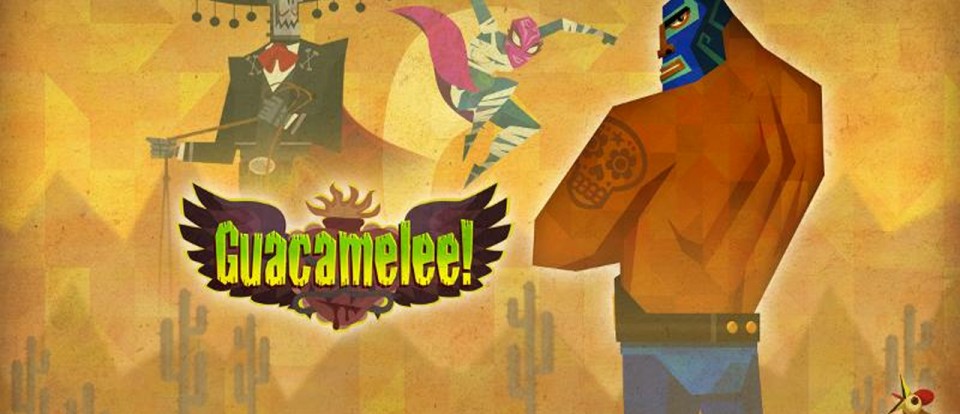
“Playing” Mexican in Guacamelee!
Posted on April 22nd, 2013
by
David O' Grady
Mainstream videogames often shy away from interpretative ambiguity, finding commercial safety—and ludic economy—in well-worn generic personas and dramatic milieus. Terrorists, monsters, aliens, Nazis—these are the culturally uncomplicated enemies who, in stereotypical scenarios and archetypal narrative arcs, must be slain by the solitary hero (i.e., the player) on a quest to save the princess/community/world.
But what happens when a videogame uses people, places and contexts that aren’t so culturally clear-cut or historically remote? This is often the space in which indie and art-project videogames operate, offering through simulation various interpretations of real-life people, issues and events. When big-budget games do attempt to play with ongoing social conflicts, or with aspects of race, gender, class and other complex cultural representations, they do so at great financial risk and critical punishment. Certain titles justifiably earn our scorn for their cultural callowness: consider the first-person shooter Call of Juarez: The Cartel (Ubisoft, 2011), a game that twists the real horrors of cartel violence and human trafficking on the Mexican border into a racist, clichéd, fear-mongering narrative about white slavery. For a stirring takedown of the game—and remarkable analysis of the drug war in Ciudad Juárez—see the compelling Extra Credits review.
Bad-faith media objects abound, but perhaps the more challenging case for analysis would be a mainstream videogame that attempts to honestly—but humorously—replicate cultural tropes for playful purposes. For example, I’ve been playing Guacamelee! (2012), a Mexican-themed, platform-style game now available for download on the PlayStation Network. As the assistant editor of Aztlán: A Journal of Chicano Studies published at UCLA, I’m keenly attuned to issues of Chicano representation, and I was eager to play a mainstream game in which a Mexican milieu, regardless of abstraction and superficiality, permeates a game’s aesthetics.
To begin with the play experience, Guacamelee! is a delight: its stylized-yet-evocative Southwestern visual treatment, inventive level design, and clever reworking of traditional platformer mechanics, make it a stand-out among the recent waves of “Metroidvania”-style games. In terms of tone, the game literally plays for laughs: your avatar, Juan Aguacate (“John Avocado”) dons a lucha libre mask, bestowing him with the wrestling skills necessary to battle Day of the Dead-themed skeletons and earn health enhancements from candy carts—powers necessary to help save El Presidente’s kidnapped daughter from the evil Carlos Calaca. My favorite trophy so far sums up the game’s vibe: “We built this city on Guac and roll.”
What playing a game in which punching piñatas releases showers of gold coins means in a larger cultural context becomes a curious question. Chicano videogame blogger Jorge Albor played Guacamelee! and penned a fascinating, nuanced essay about his thoughts (also reposted at Kotaku) on the game’s use of Mexican iconography, popular culture, and mythology.
Albor’s response to the game’s appropriations is caught between the pleasures of the game and uncertainty about its cultural implications. However, he does take exception with the game’s employment of the controversial, mythological figure X’tabay:
X’tabay is a particularly strange inclusion in the game. The female villain, temporary lover to Calaca, is the first boss players face in the game. The foundational lore of X’tabay is rooted in the story of a succubus-like goddess or demon. While this mythology is particularly old, the figure of a traitorous and lustful woman has a long and sordid history in Mexican culture. Most notably, Malinche, a real woman who was blamed for many years for ultimate conquest of Mexico, remains a powerful icon that carries with it X’tabay’s connotations of sexism in Mexican culture. The cultural significance of Malinche is immense and deeply contested. Not surprisingly, Malinchista is still used as an insult against those who stray too far from Mexican culture.
An important research point here for game designers: some cultural borrowings—no matter how remote—may still resonate deeply, and more adversely, than others. Albor concludes, however, that taking offense may not even be the most productive frame for his response. “Am I offended? I don’t know. That’s the wrong question to ask. Reactions to cultural portrayals are deeply personal. We are better off asking what does the game do right? What does the game do wrong? And is the game made with care?”
In the light of these productive questions, Guacamelee! proves compelling because, for the most part, the Canadian videogame studio behind the game (Drinkbox) did much “right” in terms of tone and selection. But for me, a lingering question remains: as an Anglo, what are the implications of playing a Mexican character? To experience alterity—without resorting to oppressive exoticism, cynical stereotypes, or false identification—is one of the great pleasures of videogaming in particular, and play in general. One hopes that to play “the other” can lead in some small way to multicultural curiosity, appreciation and even understanding. That’s perhaps a lot to ask of a joyful lark such as Guacamelee!, but the broad shoulders of Juan Aguacate can probably handle it.
